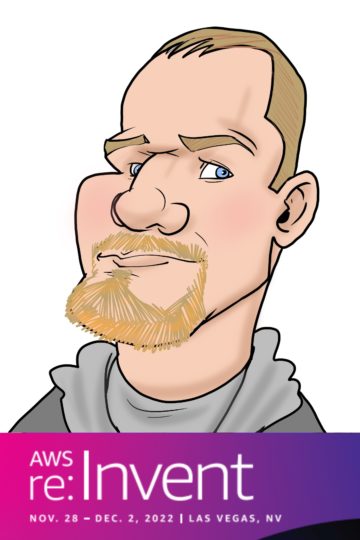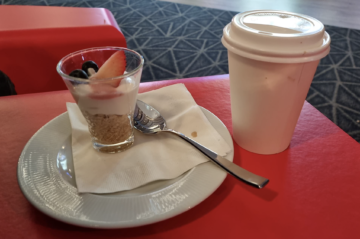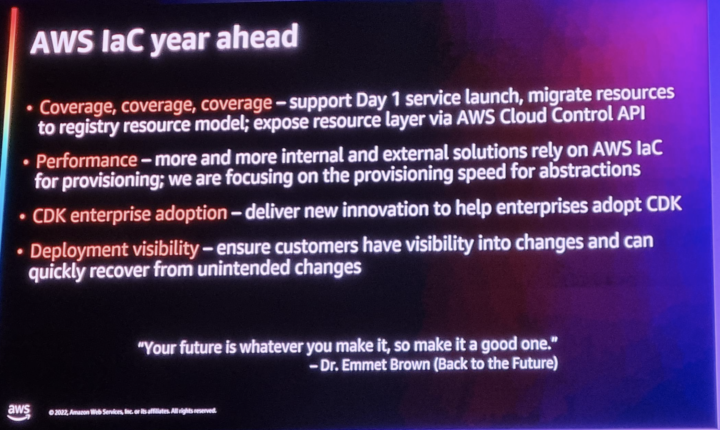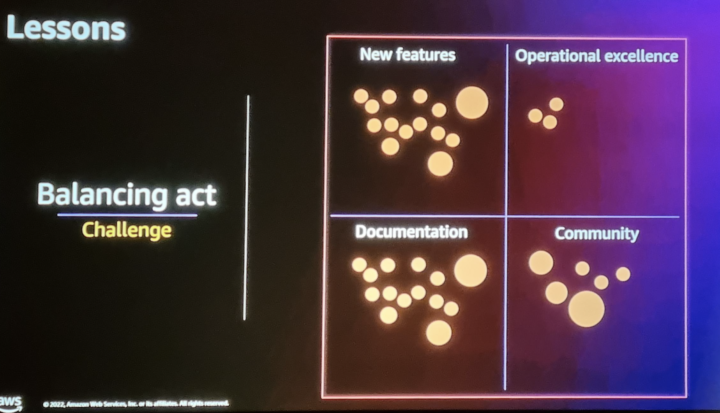
AWS re:Invent greetings from Tuesday
Tuesday started with breakfast in the Venetian and watching the keynote of Adam Selipsky (CEO of Amazon Web Services).
Keynote Adam Selipsky (KEY302)
It showed that all the other people wanted to watch Mr. Selipsky live. About 45 minutes before the massive ballroom was fully occupied. As a backup plan I watched the keynote in the registration lounge in Venetian. I shared a cozy sofa with my colleagues Tero and Joonas.
Mr. Selipsky went from space deep under the water, and from there to a high mountain with tricky transitions. He remind us that during the next five years the amount of data that exists will doubled. During the talk, he announced several interesting new services/features that people loved based on cheers. Multiple new integrations and services provide capabilities to make extraction and analysis easier. For full coverage you need to visit AWS news blog. Here is the list of top announcements from Monday and Tuesday which got my attention.
Lambda with Java has the lowest cold start delay after today. How crazy is that?
For example Lambda with NodeJS is popular because it has a very short cold start delay. It means the time to initialize the lambda before it can handle requests. On the contrary, Java is famous for having problematic cold start delays. The lambda itself is slower and in addition to that, Java apps are typically use SpringBoot-like platforms. The cold start time can then vary anything from a few seconds to 30-60 seconds.
The free Lambda SnapStart feature runs the initialisation phase automatically after each code deployment. At the end, it creates a snapshot of the lambda’s memory. Later, when the lambda is actually invoked, the memory snapshot is restored and no initialisation work is required. It makes the cold start 10-1000x faster depending on the function.
Check out Jeff’s blog post for more information or just test it by yourself!
Serverless AWS OpenSearch for big and spiky workloads
From the AWS website: “Amazon OpenSearch Service makes it easy for you to perform interactive log analytics, real-time application monitoring, website search, and more”. After today we don’t need to scale up and down the cluster when using Amazon OpenSearch Serverless. The new release will automatically scale the domain up and down based on the load of indexing and searching.
The pricing is always crucial information. The smallest cluster size costs about 690 USD/month. So it is probably the most expensive serverless product in AWS. With on-demand instances we can get almost 400% more CPU and RAM for the same price. So, it will be very expensive even with relatively steady workloads.
Good news is that saving data is much more affordable than with on-demand nodes. The data storage costs are very low compared to on-demand nodes (0,024€/GB vs. 0,122€/GB). Serverless stores data to AWS S3 service. More information can be found from documentation.
The AWS Local Zone for Helsinki and Copenhagen was opened
If you need to run low latency software in Finland or Denmark, you can use AWS Local Zone service. Both work under the Stockholm region and provide a small set of services and their features. More information about services.
Sessions on Tuesday
Putting cost optimization into practice (ARC202) was a workshop session. During the session, I was able to test AWS services like AWS S3 for storing files, AWS Glue to make a searchable database from it, and finally make visualizations and reports with AWS QuickSight. The QuickSight service usage was new for me like almost all business intelligence (BI) products.We extracted data from AWS Cost and usage reports (CUR) with very tested documented guidance.
Between sessions I visited the RIOT Games breakout room to have cappuccino and desert.
What’s new in contact centers with Amazon Connect (BIZ202) I visited quickly after the previous workshop. The Amazon Connect service is totally new for me. It can for example recognise the caller by voice and then the worker does not need to ask security questions if the risk factor is low. How cool that is!
The corridors are always busy when more than 50 000 people are moving around.
“AWS Infrastructure as Code Year ahead” session also between other booked sessions briefly. The last slide summarizes where the IAC world is going based on AWS.
Some fruits for the snack on Tuesday.
AWS Lambda Powertools: Lessons from the road to 10 million downloads (OPN306) session was all about how to manage open source projects for thousands of developers and collaborators. The project needed to pull the handbreak for months to work on operational excellence and not just creating new features and documentations.
The rooms have multiple nice decorations like this all over the venues.
AWS Well-Architected Framework: Improve performance with caching (ARC402) was a chalk talk session. The session did not go very deep even though it was a 400 level session. The questions were from common scenarios. For me it was a good recap of different cache techniques and methods.
After the session it was again time to decide which reception to go to. I decided to go to the AWS EMEA reception to The Mirage Hotel Ballroom with Joonas, Tero and Ville.
 In the reception there was artists to draw picture of you.
In the reception there was artists to draw picture of you.





